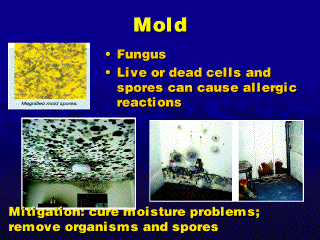 This is the latest and trendiest indoor air pollution problem, although it
has been around for decades, if not centuries.
This is the latest and trendiest indoor air pollution problem, although it
has been around for decades, if not centuries. This is the latest and trendiest indoor air pollution problem, although it
has been around for decades, if not centuries.
This is the latest and trendiest indoor air pollution problem, although it
has been around for decades, if not centuries.
Mold tends to grow in moist places, so there is no house that is truly mold-free. Some homes, as can be seen in the photographs, do have excessive amounts of mold because of problems with moisture accumulation--too much humidity, water leaks, flood damage. Check out some photographs of houses that got flooded by the storm surge from Hurricane Katrina in New Orleans.
Most problems with molds are due to allergic reactions to the mold organisms (either live or dead cells) or to the spores of molds (like seed or pollen). There may be hayfever symptoms, aggravated asthma, and immune system problems thought to be either due to sleep disruption from the allergic reactions, or chemical sensitivities to mold by-products.
The latest scares about mold involve the black Stachybotrys mold, which is known to produce chemicals that are very toxic to humans. However, the occurrence of this mold compared to the frequency of occurrence of allergic reactions is much smaller, so this is really a minor problem.
The only certified methods of remediating
a mold problem is to physically remove the mold organisms (using techniques
similar to asbestos removal), filter the air of dead mold and mold spores, and
resolve the excessive moisture problems that caused the mold growth in
the first place (getting rid of the moisture is actually the first task, since the mold will just grow back in if the room is not dry). Non-certified methods involve treating the air with UV radiation,
which kills the airborne mold and spores so they cannot spread and reproduce
(but you still have to do a mold removal session).